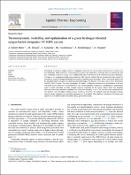Options
Thermodynamic modelling and optimisation of a green hydrogen-blended syngas-fueled integrated PV-SOFC system
Author(s)
Date Issued
2024-01-05
Date Available
2025-05-30T09:16:21Z
Abstract
Developing an effective energy transition roadmap is crucial in the face of global commitments to achieve net zero emissions. While renewable power generation systems are expanding, challenges such as curtailments and grid constraints can lead to energy loss. To address this, surplus electricity can be converted into green hydrogen, serving as a key component in the energy transition. This research explores the use of renewable solar energy for powering a proton exchange membrane electrolyser to produce green hydrogen, while a downdraft gasifier fed by municipal solid waste generates hydrogen-enriched syngas. The blended fuel is then used to feed a Solid Oxide Fuel Cell (SOFC) system. The study investigates the impact of hydrogen content on the performance of the fuel cell-based power plant from thermodynamics and exergoeconomic perspectives. Multiobjective optimisation using a genetic algorithm identifies optimal operating conditions for the system. Results show that blending hydrogen with syngas increases combined heat and power efficiency by up to 3%, but also raises remarkably the unit product cost and reduces carbon dioxide emissions. Therefore, the optimal values for hydrogen content, current density, temperatures, and other parameters are determined. These findings contribute to the design and operation of an efficient and sustainable energy generation system.
Type of Material
Journal Article
Publisher
Elsevier
Journal
Applied Thermal Engineering
Volume
236
Copyright (Published Version)
2023 the Authors
Language
English
Status of Item
Peer reviewed
ISSN
1359-4311
This item is made available under a Creative Commons License
File(s)
Loading...
Name
2024-Thermodynamic modelling and optimisation of a green hydrogen-blended.pdf
Size
8.76 MB
Format
Adobe PDF
Checksum (MD5)
109da269cf3b60649436c05096754731
Owning collection